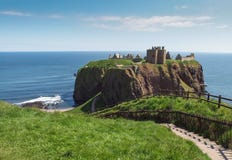Dunnottar Castle,Stonehaven, Aberdeenshire, Scotland, Uk,. Donnottar Castle, Stonehaven, Aberdeenshire, Scotland, Uk, Just Out Of Stonehaven On The A90. Dunnottar Castle, "Fort On The Shelving Slope") Is A Ruined Medieval Fortress Located Upon A Rocky Headland On The Northeastern Coast Of Scotland, About 2 Miles (3.2 Km) South Of Stonehaven. The Surviving Buildings Are Largely Of The 15Th And 16Th Centuries, But The Site Is Believed To Have Been Fortified In The Early Middle Ages. Dunnottar Has Played A Prominent Role In The History Of Scotland Through To The 18Th-Century Jacobite Risings Because Of Its Strategic Location And Defensive Strength. Dunnottar Is Best Known As The Place Where The Honours Of Scotland, The Scottish Crown Jewels, Were Hidden From Oliver Cromwell'S Invading Army In The 17Th Century. The Property Of The Keiths From The 14Th Century, And The Seat Of The Earl Marischal, Dunnottar Declined After The Last Earl Forfeited His Titles By Taking Part In The Jacobite Rebellion Of 1715. The Castle Was Restored In The 20Th Century And Is Now Open To The Public. The Ruins Of The Castle Are Spread Over 1.4 Hectares (3.5 Acres), Surrounded By Steep Cliffs That Drop To The North Sea, 160 Feet (49 M) Below. A Narrow Strip Of Land Joins The Headland To The Mainland, Along Which A Steep Path Leads Up To The Gatehouse. The Various Buildings Within The Castle Include The 14Th-Century Tower House As Well As The 16Th-Century Palace. Dunnottar Castle Is A Scheduled Monument, And
ID 26637332 © Loinshoes | Megapixl.com
CATEGORIES
EXCLUSIVE
Sharing is not just caring, it's also about giving credit - add this image to your page and give credit to the talented photographer who captured it.:
KEYWORDS
aberdeenshire ancient architecture background backgrounds blue brave brick building buildings castle dunnottar flowers historic history ruins scotland sky stone stonehaven walls well window path footpath northeastern coast coastal rock cliff cliffs hill hills headland rocky keep sea seascape landscape coastline grass




































































